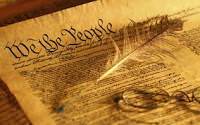2.2: Constitutional Provisions for Limiting the Role of Government
- Page ID
- 2000
\( \newcommand{\vecs}[1]{\overset { \scriptstyle \rightharpoonup} {\mathbf{#1}} } \)
\( \newcommand{\vecd}[1]{\overset{-\!-\!\rightharpoonup}{\vphantom{a}\smash {#1}}} \)
\( \newcommand{\id}{\mathrm{id}}\) \( \newcommand{\Span}{\mathrm{span}}\)
( \newcommand{\kernel}{\mathrm{null}\,}\) \( \newcommand{\range}{\mathrm{range}\,}\)
\( \newcommand{\RealPart}{\mathrm{Re}}\) \( \newcommand{\ImaginaryPart}{\mathrm{Im}}\)
\( \newcommand{\Argument}{\mathrm{Arg}}\) \( \newcommand{\norm}[1]{\| #1 \|}\)
\( \newcommand{\inner}[2]{\langle #1, #2 \rangle}\)
\( \newcommand{\Span}{\mathrm{span}}\)
\( \newcommand{\id}{\mathrm{id}}\)
\( \newcommand{\Span}{\mathrm{span}}\)
\( \newcommand{\kernel}{\mathrm{null}\,}\)
\( \newcommand{\range}{\mathrm{range}\,}\)
\( \newcommand{\RealPart}{\mathrm{Re}}\)
\( \newcommand{\ImaginaryPart}{\mathrm{Im}}\)
\( \newcommand{\Argument}{\mathrm{Arg}}\)
\( \newcommand{\norm}[1]{\| #1 \|}\)
\( \newcommand{\inner}[2]{\langle #1, #2 \rangle}\)
\( \newcommand{\Span}{\mathrm{span}}\) \( \newcommand{\AA}{\unicode[.8,0]{x212B}}\)
\( \newcommand{\vectorA}[1]{\vec{#1}} % arrow\)
\( \newcommand{\vectorAt}[1]{\vec{\text{#1}}} % arrow\)
\( \newcommand{\vectorB}[1]{\overset { \scriptstyle \rightharpoonup} {\mathbf{#1}} } \)
\( \newcommand{\vectorC}[1]{\textbf{#1}} \)
\( \newcommand{\vectorD}[1]{\overrightarrow{#1}} \)
\( \newcommand{\vectorDt}[1]{\overrightarrow{\text{#1}}} \)
\( \newcommand{\vectE}[1]{\overset{-\!-\!\rightharpoonup}{\vphantom{a}\smash{\mathbf {#1}}}} \)
\( \newcommand{\vecs}[1]{\overset { \scriptstyle \rightharpoonup} {\mathbf{#1}} } \)
\( \newcommand{\vecd}[1]{\overset{-\!-\!\rightharpoonup}{\vphantom{a}\smash {#1}}} \)
\(\newcommand{\avec}{\mathbf a}\) \(\newcommand{\bvec}{\mathbf b}\) \(\newcommand{\cvec}{\mathbf c}\) \(\newcommand{\dvec}{\mathbf d}\) \(\newcommand{\dtil}{\widetilde{\mathbf d}}\) \(\newcommand{\evec}{\mathbf e}\) \(\newcommand{\fvec}{\mathbf f}\) \(\newcommand{\nvec}{\mathbf n}\) \(\newcommand{\pvec}{\mathbf p}\) \(\newcommand{\qvec}{\mathbf q}\) \(\newcommand{\svec}{\mathbf s}\) \(\newcommand{\tvec}{\mathbf t}\) \(\newcommand{\uvec}{\mathbf u}\) \(\newcommand{\vvec}{\mathbf v}\) \(\newcommand{\wvec}{\mathbf w}\) \(\newcommand{\xvec}{\mathbf x}\) \(\newcommand{\yvec}{\mathbf y}\) \(\newcommand{\zvec}{\mathbf z}\) \(\newcommand{\rvec}{\mathbf r}\) \(\newcommand{\mvec}{\mathbf m}\) \(\newcommand{\zerovec}{\mathbf 0}\) \(\newcommand{\onevec}{\mathbf 1}\) \(\newcommand{\real}{\mathbb R}\) \(\newcommand{\twovec}[2]{\left[\begin{array}{r}#1 \\ #2 \end{array}\right]}\) \(\newcommand{\ctwovec}[2]{\left[\begin{array}{c}#1 \\ #2 \end{array}\right]}\) \(\newcommand{\threevec}[3]{\left[\begin{array}{r}#1 \\ #2 \\ #3 \end{array}\right]}\) \(\newcommand{\cthreevec}[3]{\left[\begin{array}{c}#1 \\ #2 \\ #3 \end{array}\right]}\) \(\newcommand{\fourvec}[4]{\left[\begin{array}{r}#1 \\ #2 \\ #3 \\ #4 \end{array}\right]}\) \(\newcommand{\cfourvec}[4]{\left[\begin{array}{c}#1 \\ #2 \\ #3 \\ #4 \end{array}\right]}\) \(\newcommand{\fivevec}[5]{\left[\begin{array}{r}#1 \\ #2 \\ #3 \\ #4 \\ #5 \\ \end{array}\right]}\) \(\newcommand{\cfivevec}[5]{\left[\begin{array}{c}#1 \\ #2 \\ #3 \\ #4 \\ #5 \\ \end{array}\right]}\) \(\newcommand{\mattwo}[4]{\left[\begin{array}{rr}#1 \amp #2 \\ #3 \amp #4 \\ \end{array}\right]}\) \(\newcommand{\laspan}[1]{\text{Span}\{#1\}}\) \(\newcommand{\bcal}{\cal B}\) \(\newcommand{\ccal}{\cal C}\) \(\newcommand{\scal}{\cal S}\) \(\newcommand{\wcal}{\cal W}\) \(\newcommand{\ecal}{\cal E}\) \(\newcommand{\coords}[2]{\left\{#1\right\}_{#2}}\) \(\newcommand{\gray}[1]{\color{gray}{#1}}\) \(\newcommand{\lgray}[1]{\color{lightgray}{#1}}\) \(\newcommand{\rank}{\operatorname{rank}}\) \(\newcommand{\row}{\text{Row}}\) \(\newcommand{\col}{\text{Col}}\) \(\renewcommand{\row}{\text{Row}}\) \(\newcommand{\nul}{\text{Nul}}\) \(\newcommand{\var}{\text{Var}}\) \(\newcommand{\corr}{\text{corr}}\) \(\newcommand{\len}[1]{\left|#1\right|}\) \(\newcommand{\bbar}{\overline{\bvec}}\) \(\newcommand{\bhat}{\widehat{\bvec}}\) \(\newcommand{\bperp}{\bvec^\perp}\) \(\newcommand{\xhat}{\widehat{\xvec}}\) \(\newcommand{\vhat}{\widehat{\vvec}}\) \(\newcommand{\uhat}{\widehat{\uvec}}\) \(\newcommand{\what}{\widehat{\wvec}}\) \(\newcommand{\Sighat}{\widehat{\Sigma}}\) \(\newcommand{\lt}{<}\) \(\newcommand{\gt}{>}\) \(\newcommand{\amp}{&}\) \(\definecolor{fillinmathshade}{gray}{0.9}\)
The framers of the Constitution wanted to create an entirely new form of democratic government -- a Federal Republic. To accomplish this task, they carefully considered the problems with previous forms of government and examined the Enlightenment ideas that had so greatly influenced them up to that point. However, they knew that an even more daring experiment in democracy was needed, so they mixed the Enlightenment ideals of the past with new and uniquely American thoughts on self-government and devised a document that in little more than 4,000 words (quite short for a document of its nature) completely laid out a new blueprint for government that we know as the United States Constitution.
For this system to be effective, the framers had to carefully interweave six principles of Constitutional government. These were:
Popular Sovereignty
Limited Government
Separation of Powers
Checks and Balances
Judicial Review
Federalism
When the Framers of the Constitution set about creating a new constitutional form of government, they wanted a document that would divide, distribute, balance, and protect governmental powers, and ensure that the liberties and rights of the people were protected. To achieve this, they instituted a series of important principles into the new Constitution.
Of course, they did not do this without a little help from those giants upon whose shoulders they knew they were standing – the Enlightenment philosophers such as Hobbes, Locke, Rousseau, and Montesquieu. While we have talked about the influence of these enlightened thinkers, it is probably a good time to remind ourselves of their importance.
These brave men, the Founding Fathers, were working in unknown and untested territory – the creation of an entirely new form of Democracy (which would be described as a Federal Republic). In order to go about this grand experiment, the Founding Fathers instituted a number of important philosophical principles which we will call “Constitutional Ideals.” These are described in the chart below:
|
POPULAR SOVEREIGNTY |
People establish governments and are the source of all governmental powers. People tell the government what to do instead of governments controlling the lives of the people. |
|
LIMITED GOVERNMENT |
Governments must have restricted and highly controlled power so that they do not exercise “tyranny” or unrestrained power over the people. Individual rights must be “firewalled” and protected from government abuse. |
|
SEPARATION OF POWERS |
Government power is divided among branches. In U.S. Government there are three branches: the Legislative (lawmaking), Executive (Implement and Execute laws), and Judicial (Interpret and enforce laws). |
|
CHECKS AND BALANCES |
In order to ensure that no one branch of government wields too much power over the others, each branch is given authority to check or restrain some of the powers of the other branches. |
|
JUDICIAL REVIEW |
The judiciary (Supreme Court and lower courts) has the power to strike down laws and other government actions as unconstitutional. |
|
FEDERALISM |
The powers and rights of the states are protected and balanced with powers and rights given to the national government through a process of division and power-sharing as outlined in the Constitution. |
Once these basic principles of governing were identified, they were included in the new Constitution. The Founding Fathers believed that if the new federal government could be instituted in such a way as to reflect these basic principles and could stay true to them over time, this new experiment just might work. Of course, now more than 227 years later, they did such a good job, the document has only had to be formally changed 27 times to date. Of those 27 formal changes, ten of them were made in the first two years of the new Constitution in order to create our nation’s Bill of Rights.
In its original form, the U.S. Constitution runs just over 4,500 words. In comparison to other national constitutions, and the individual state constitutions, this is a brief document. In it, the Founding Fathers have offered us an outline for governance that has incorporated ideas that had worked for other governments in the past, as well as new and uniquely "American" ideas that make our Constitution something that has been the envy (and the model) of modern democracies throughout history.
Principles of the Constitution
Video: Principles of the Constitution
Republicanism
A political philosophy that has been a major part of American civic thought since its founding is called Republicanism. American republicanism was first expressed and first practiced by the Founding Fathers. The concept stemmed from their experiences with the monarchy in Great Britain.
The idea of Republicanism promotes liberty and unalienable rights as central values, making people sovereign, or able to rule themselves. Republicanism rejects monarchy, aristocracy, and inherited political power. It also expects citizens to be virtuous and faithful in their performance of civic duties, and vilifies corruption. A Republic should prepare for the negative influences that could place the nation in a perilous situation leading to tyranny or dictatorship. For example, Republicanism believes that a government official should not run for or hold a public office for personal gain, but rather to benefit the whole community.
Under Republicanism, all citizens were considered equal, but the definition of citizen has changed throughout the years. When the United States of America was first formed, for example, a black person was not considered a citizen.
Today’s Republicanism is very different. The guiding principles are interpreted differently from the Republicans who initially created the concept in the Renaissance.
Video: Classical Republicanism
Individual Rights
According to scholars today, Jefferson acquired the most famous ideas in the Declaration of Independence from the writings of English philosopher John Locke. In 1689, Locke wrote Second Treatise of Government. This was during England's Glorious Revolution, which overthrew the rule of James II.
In his treatise, Locke identified the basis of a legitimate government. A ruler gains authority through the consent of the governed Locke stated. The government’s duty is to protect the natural rights of the people-- life, liberty, and property.
If the government did not protect these rights, its citizens would have the right to overthrow that government. This idea deeply influenced Thomas Jefferson as he drafted the Declaration of Independence.
Video: Natural Rights, Social Contract, Democracy, Republicanism, and Limited Government

Study/Discussion Questions
For each of the following terms, write a sentence which uses or describes the term in your own words.
|
popular sovereignty |
limited government |
separation of powers |
|
checks and balances |
judicial review |
federalism |
1. Compare and contrast the political theory of Classical Republicanism and today's Republicans.
2. Describe the influence that John Locke's ideas about individual rights had on Thomas Jefferson's draft of the Constitution.

